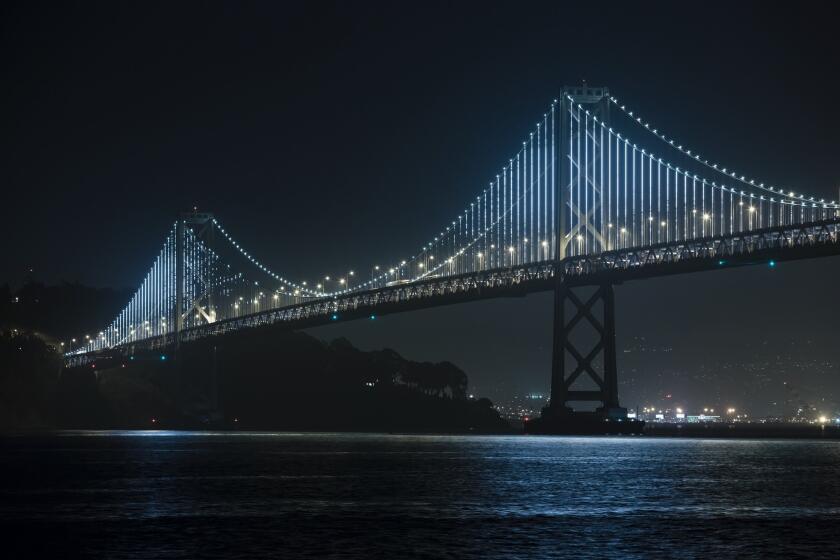LAX Guards Against Portable Missile Attacks
Counterterrorism officials, prompted by a series of overseas attacks against commercial airliners, have quietly taken steps to protect jetliners at Los Angeles International Airport from terrorists armed with shoulder-launched missiles.
Although there is no credible intelligence indicating that terrorists have planned such an attack at LAX, the officials say the security measures are needed because portable weapons are easy to buy on the international arms market and are deadly, with infrared guidance systems that lock onto the heat emitted by jetliners’ engines.
The security measures, instituted over the last year, include increased police patrols around the airport, new perimeter fencing, stepped-up training to help personnel spot the tubular weapons and expanded helicopter surveillance during terrorism alerts so a missile’s route could be tracked in the event of an attack.
A Rand Corp. report commissioned by airport authorities said earlier this year that LAX is “a particularly attractive target” for terrorists and outlined ways of reducing the risk of attacks involving so-called man-portable air defense systems.
“I think the threat has been continually underestimated by the decision makers in Washington,” said U.S. Sen. Barbara Boxer (D-Calif.), who has urged the Department of Homeland Security to accelerate plans for installing missile defense on commercial aircraft.
In a recent interview, Boxer said the FBI and various counterterrorism experts have warned in numerous reports about the threat. “I’m telling you, I am reading these things and I’m losing sleep at night,” she said.
Terrorists have never fired a shoulder-launched missile at an airplane in the U.S. But the small missiles, weighing less than 40 pounds, have been used to shoot down two dozen commercial aircraft around the world over the last three decades and could be smuggled into the U.S. A successful attack in the U.S. could ground the entire commercial airline fleet, some experts believe.
“The threat is real,” John Miller, the Los Angeles Police Department’s counterterrorism chief, said in an interview after appearing at a counterterrorism conference last month at USC. “With about 20,000 of these available on the black market, for $2,000 to $3,000 each, there is no indication it will not be tried again.”
During his keynote speech to the conference, Miller described the shoulder-fired missiles as “part of the terrorists’ future” in the U.S.
Just last year, a DHL cargo jet was hit by a shoulder-fired missile as it departed from Baghdad International Airport. The attack, videotaped by insurgents, caused the aircraft to return to the airport for an emergency landing.
In the last 30 years, security experts said, LAX has been the site of five attacks or attempted attacks by terrorists, including the so-called millennium plot that was thwarted in December 1999. Border authorities apprehended Ahmed Ressam as he tried to drive a car laden with explosives into the country from Canada. He was later convicted of plotting with Al Qaeda to bomb LAX.
Counterterrorism officials see shoulder-fired missiles as a looming threat in the United States in part because tighter airport screening measures -- promoted by the Sept. 11 terrorist attacks -- have made it harder for extremists to hijack an airliner and down it from within.
Although the cost, capabilities and technologies of the weapons vary greatly depending on when and where they were built, experts say a critical factor is their range. The oldest shoulder-fired missiles can hit a target more than a mile away. The newer models can strike aircraft as high as 15,000 feet, or about three miles.
Jack Riley, director of Rand’s Homeland Security Center, said he considers shoulder-launched missiles a greater domestic threat than bioterrorism or suicide bombings because they can be used without intricate planning and do not require the fanatical sacrifice of suicide.
“If there is a [shoulder-launched missile] attack, it is likely going to be coordinated around the country,” Riley said. “And I think it is reasonable to assume that LAX would be one of the sites targeted since it is one of the world’s busiest airports.”
A federal counterterrorism official agreed. “LAX is a very large and difficult place to protect,” the official said. “And with so many flights, it would just be a matter of someone driving up there, and within 60 seconds it would all be over. Even an F-16 is not going to do anything. By the time it responds, that [missile] will already be gone.”
The U.S., Russia and a dozen other countries have produced at least 500,000 shoulder-launched missiles since the 1960s, thousands of which are available on the black market, according to Terry O’Sullivan of USC’s Center for Risk and Economic Analysis of Terrorism Events.
The CIA supplied U.S.-made Stinger missiles in 1986 to the Afghan mujahedin fighting the Soviet Union in Afghanistan. The highly accurate shoulder-launched weapons helped turn the course of the war. They are credited with downing about 270 Soviet helicopter gunships and other aircraft. But after the war, authorities could not account for many of them.
Since the mid-1970s, the two dozen attacks with shoulder-launched missiles on “large and slower moving” commercial airliners have killed almost 1,000 people, said USC’s O’Sullivan.
The most recent occurred in Kenya in November 2002, when two shoulder-launched missiles were fired at -- but missed -- a jet operated by Arkia, an Israeli charter airline, carrying 271 people.
“Lots of analysts say it is just a matter of time before we see it domestically,” O’Sullivan said. “And I think the reason people are talking about it now is that they see it as a growing danger.”
Why the weapons have not been used yet in the U.S. is “the million-dollar question,” said Jim Chow, a senior engineer at Rand who has written a new study, due to be issued next month, on the portable missile threat.
“They are easy to buy on the black market, but bringing them here and finding someone to use them is another matter,” he added.
Another federal counterterrorism official expressed some comfort in the fact that newer, more sophisticated shoulder-launched missiles are much harder to find on the black market than older models that are far less accurate and reliable.
Still, that official and other experts said that terrorists have shown time and again their ability to damage, if not cripple, commercial jetliners if they can get within range of many portable missiles.
As O’Sullivan said at the USC terrorism conference: “For anyone who has flown over LAX or San Diego’s airport, think about how low these planes fly.”
In its study earlier this year, Rand concluded that LAX could be safer from the threat of shoulder-fired missiles if authorities greatly expanded police patrols and examined new technologies. But the report says the increased patrols would cost Los Angeles an estimated $8 million a year.
The report cited only one high-tech solution, a high-energy laser that could shoot down shoulder-launched missiles. Northrop Grumman is developing such a system at its facility in Redondo Beach that it hopes to market with government approval for use at commercial airports.
Chow, the Rand engineer, said the range of the shoulder-fired missiles makes attacks difficult to prevent, especially at airports like LAX that are virtually surrounded by office towers and residential neighborhoods.
“These things can strike an aircraft from three miles away,” Chow said. “That’s what makes it such a challenging problem.”
At the federal level, Boxer’s most far-reaching proposal calls for retrofitting the nation’s commercial airliners with onboard lasers that destroy a portable missile’s infrared guidance sensor.
The laser defense, which would cost about $1 million per jetliner, is already in use among the U.S. military’s C-17 transport jets. Northrop Grumman and BAE Systems are vying for a contract from the Department of Homeland Security to produce the onboard lasers for commercial aircraft.
“I fear that the only way we will respond to this appropriately is after an attack,” Boxer said.
More to Read
Start your day right
Sign up for Essential California for news, features and recommendations from the L.A. Times and beyond in your inbox six days a week.
You may occasionally receive promotional content from the Los Angeles Times.






